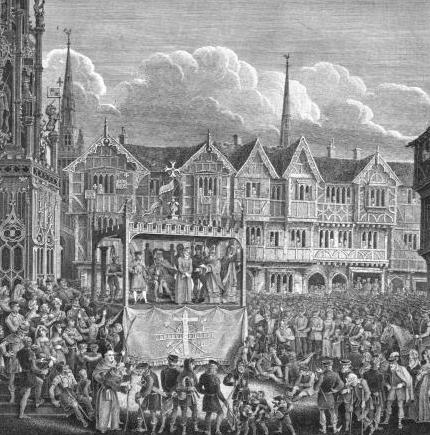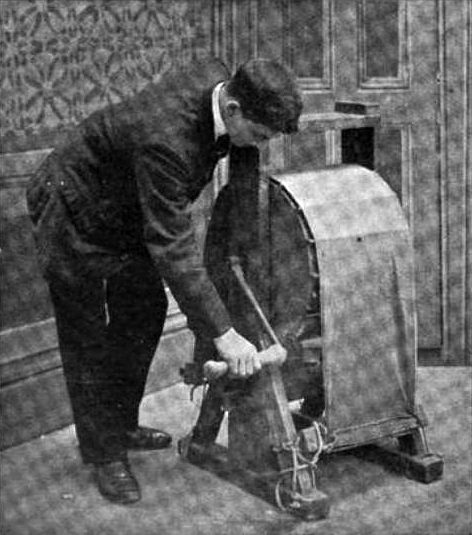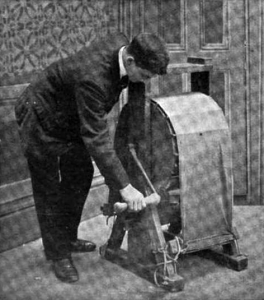
How were props made in Medieval theatres? Before Shakespeare’s time, European theatre consisted of festivals and traveling religious pageants. Trade guilds were maturing into full-fledged institutions by the fourteenth century. It would seem that most of the props (and other production values) were provided by these guilds.
Gradually, too, the priests lost their hold even on the plays themselves; skillful actors from among the laymen began to take many of the parts; and at last in some towns the trade-guilds, or unions of the various handicrafts, which had secured control of the town governments, assumed entire charge…
Generally each play was presented by a single guild (though sometimes two or three guilds or two or three plays might be combined), and sometimes, though not always, there was a special fitness in the assignment, as when the watermen gave the play of Noah’s Ark or the bakers that of the Last Supper. In this connected form the plays are called the Mystery or Miracle Cycles…
(A History of English literature for Students, by Robert Huntington Fletcher, 1916: pp. 85-88)
Thus it would appear the productions were very artisan-based; a ship was built as a ship would be built, rather than as some cheap facsimile. We read further that:
at York before 1378 the management of the different plays was already divided out between the different crafts, and it is probable that the allusions to the method of representation which have been gleaned from later records apply equally well to these fourteenth century performances…
On the morning of the performance each pageant would be rolled out of its shed and dragged in its turn to the first of the ‘stations’ at which the plays were acted. The first performance over, the pageant would be dragged through the streets to the second station, and then the play repeated. At York each play was performed twelve times, and occasionally oftener, the choice of the stopping places or stations being determined by the liberality of the owners of the adjacent houses. These contributions were much needed, for the cost of the plays fell heavily on the guilds; five or six of them had sometimes to club together to produce a single pageant, while the sharing of the expenses led to frequent disputes. In a few cases the reason for the assignment of a play to a particular guild is obvious; thus the Shipwrights or Fishmongers commonly interested themselves in Noah and the Flood, while the Goldsmiths and Goldbeaters played the Magi. But as a rule the wealth of the guild and the cost of the necessary dresses and stage properties were the chief considerations.
(Chamber’s Cyclopædia of English Literature, by Robert Chambers, 1902: pp. 47-48)
and
Each guild was entrusted as far as possible with a performance in harmony with the character of its own craft; thus the building of the Ark was represented by the shipwrights. The number of these associations seems startling, until the great subdivision of labour in the Middle Age is considered, and the jealousy lest one craft should encroach on the domain of another. We hear o’ bladesmiths, sheathers, buckle-makers, girdelers, corvisors (shoemakers), spicers, fletchers (arrow-makers), pinners, needlers, and whittawers (workers in white leather).
(English Literature: From the beginning of the age of Henry VIII, by Richard Garnett and Edmund Gosse, 1903: pp. 223-225)
In many ways, it would seem the guilds provided these pageants as a way to showcase the skills of their members and advertise their abilities. Between the numerous guilds, these pageants must have had quite the variety of props and costumes. Some of these pageants lasted all day, encompassing the entirety of sacred history. By dividing up the parts between the different guilds, it became economically feasible.
Let’s look at some of the more practical aspects of Medieval theatre production.
The expense accounts of the guilds, sometimes luckily preserved, furnish many picturesque and amusing items, such as these: ‘Four pair of angels’ wings, 2 shillings and 8 pence.’ ‘For mending of hell head, 6 pence.’ ‘Item, link for setting the world on fire.’…
To the guilds the giving of the plays was a very serious matter. Often each guild had a ‘pageant-house’ where it stored its ‘properties,’ and a pageant-master who trained the actors and imposed substantial fines on members remiss in cooperation.
(Fletcher)
We can compare this to a later account of expenses in my previous post on Theatrical profits and expenses in 1511.
Finally, let’s take a quick look at the construction of some of these props and effects:
There could be little attempt at scenery, but details of costume and stage fittings are abundantly supplied by the account books of the municipalities, when these have been preserved, and are full of curiosity and interest. The representation of Paradise naturally surpassed the powers of the scenic artists of that period, but they were perfectly at home in Hell, and especial pains were taken with Hell mouth, delineated as the literal mouth of an enormous monster, and with the pitchforks and clubs of the demons. The latter implements were considerately made of wadding: but the gunpowder which the fiends are enjoined to carry about various parts of their persons, if not mere brutum fulmen, in which case it might as well have been omitted, must have been productive of considerable inconvenience to the performer.
(Garnett and Gosse)
Ha ha, blowing up performers with gunpowder. That’s props!


